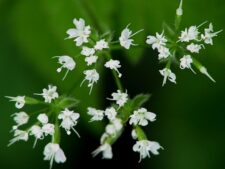
ANISE ROOT
Osmorhiza longistylis
PARSLEY FAMILY (Apiaceae)
 Identification
Identification
- Flowering time - May, June
- Common in moist woodlands - uplands, ravines, floodplain
- Clusters of tiny white flowers rising above the leaves
- Leaves divided into 3 toothed leaflets
- Narrow, ribbed seeds with long styles - see comments comparing it to very similar Sweet Cicely
This native perennial grows to 1-3 feet tall. The stems may be hairy or smooth. The leaves are divided into threes several times, resulting in groups of 3 leaflets that are lance-shaped and sharply toothed (A). As the common name suggests, the foliage when crushed may give off an anise scent. The small, white flowers are arranged in clusters (compound umbels) above the leaves. Each cluster consists of about 5 groups (umbellets) of tiny white flowers (B). The fruit is an elongated, ribbed seed. As the scientific name implies, anise root flowers have ‘long’ styles – the white pointed spikes in the image (B) which are longer than Sweet Cicely (Osmorhiza claytonii), a close relative! These 2 species are not easy to to tell apart by this field mark (or others). Please see comments section for further ID details.
This species blooms during May and June. It is common in Fontenelle Forest and Neale Woods and easily found along most wooded upland and floodplain trails.
The field mark most often used to separate Anise Root (Osmorrhiza longistylus) from closely related Sweet Cicely (Osmorrhiza claytoni) is its longer styles (1/8 vs 1/16 inch), not an easy task. The anise scent given off by the roots or crushed foliage (a destructive method prohibited at our nature centers) has also been used separate them. Some other sources indicate Anise Root has more tiny flowers (7 or more) in each umbellet. Probably best to simply enjoy your encounter with this really beautiful spring wildflower, call it Anise Root or Sweet Cicely or whatever, and have a nice walk in the woods.
Local Native Americans and early settlers collected anise roots for their sweet and aromatic taste. Tea made from the dried roots had a variety of medicinal uses as well.
The content of NatureSearch is provided by dedicated volunteer Naturalists of Fontenelle Forest who strive to provide the most accurate information available. Contributors of the images retain their copyrights. The point of contact for this page is: Roland Barth.

